Tonbridge and Malling
Explore hidden histories, historic photos, and things you never knew about Tonbridge and Malling from the collections and archives of Historic England.
Discover your local listed buildings and places
Introducing some of Tonbridge and Malling's most historic sites, included in the National Heritage List for England. Some of these captions have been summarised by AI. Click through for the official List entry. Skip this section and go to place by numbers
Finnish Olympic Sauna
Ditton
A prefabricated timber sauna manufactured by Finnish company Puutalo Oy (Timber Houses Limited) for the 1948 London Olympic Games.
Large multivallate hillfort and Palaeolithic rock shelter…
Ightham
Oldbury Hill hosts a rare large Iron Age hillfort and Palaeolithic rock shelters, highlighting human activity and social organization from ancient times.
Part of an Iron Age enclosure and a minor Roman villa 128…
East Malling & Larkfield
The minor Roman villa at East Malling is a typical example of its type, with archaeological evidence showing continuity from the Iron Age to the Roman period.
Ightham Court
Ightham
A small country house with gardens and woodland containing features surviving from the formal layout of the late C17 or early C18. Read the official list entry to find out more.
Mereworth Castle
East Peckham
Mereworth Castle, built by Colen Campbell in the early 18th century, is a Palladian villa surrounded by extensive landscaped gardens and parkland, reflecting historical ownership and...
Oxen Hoath
Hadlow
Oxen Hoath features 19th-century formal gardens by William Andrews Nesfield, complemented by architectural modifications under architects like Anthony Salvin, reflecting its rich historical...
St Mary's Abbey: a Benedictine abbey north and east of Wa…
West Malling
St Mary's Abbey, a Benedictine site founded around 1090, features surviving medieval masonry and archaeological remains significant to understanding nunnery life and architecture.
Church of St Peter
Ightham
The Church of St Peter, since circa 1400, features Norman windows, an octagonal stone pulpit from the early 15th century, and significant monuments including Sir Thomas Cawne's and William...
Church of St Mary the Virgin
Burham
The Church of St Mary the Virgin, dating from the 12th to 15th centuries, features a Norman font and a restored architecture from 1956, highlighting its historical evolution.
Town banks
Tonbridge
The medieval town defences of Tonbridge, primarily earthen banks and ditches, survive as significant landscape features and contain valuable archaeological information.
Milepost on A20 London Road at Ditton, Kent
Ditton
Early to mid-C19 cast-iron milepost attached to an earlier milestone. Read the official list entry to find out more.
The Friars, Main Block
Aylesford
The Friars, Main Block, originally founded in 1241, faced reconstruction after a 1930s fire and significant additions post-1949 return.
Church of St Dunstan
West Peckham
The Church of St Dunstan features a medieval design with a Saxon tower, 17th-century pews, and a chantry chapel built by Sir John Colepepper.
Hadlow Tower, Hadlow Castle
Hadlow
Hadlow Tower, part of the now-dismantled Gothick Hadlow Castle, is an iconic 1838 structure showcasing elaborate Roman cement detailing, reflecting the architectural ambition of the May...
Church of St James
East Malling & Larkfield
The Church of St James, largely rebuilt around 1450-1500, features historical monuments like those of Thomas Selby (1479) and Richard Mannyng (1611). It has early medieval architecture.
West Malling War Memorial
West Malling
War memorial unveiled in 1921. Read the official list entry to find out more.
Hildenborough War Memorial
Hildenborough
First World War memorial, unveiled 1920, with later additions for the Second World War. Read the official list entry to find out more.
Wateringbury War Memorial Cross
Wateringbury
First World War memorial cross, unveiled 1921, with later additions for the Second World War. Read the official list entry to find out more.
Forge Cottage
Borough Green
Cottage of late C17 or early C18 date. Re-furbished in the 1970s. Read the official list entry to find out more.
East Malling War Memorial
East Malling & Larkfield
War memorial, 1922 in stone, designed by John Ninian Comper and carved by William Drinkwater Gough. Read the official list entry to find out more.
Aylesford Goods Shed
Aylesford
Railway goods shed, built in around 1856 for the South Eastern Railway on the Medway Valley Line. Read the official list entry to find out more.
Wateringbury Signal Box
Nettlestead
Signal box, 1893, a Saxby and Farmer Type 12 design for the Maidstone to Paddock Wood branch of the South Eastern Railway. Read the official list entry to find out more.
Aylesford Signal Box
Aylesford
Signal box, 1921, constructed by the South Eastern & Chatham Railway. Read the official list entry to find out more.
Snodland Signal Box
Snodland
Signal box, 1870s, for the South Eastern Railway Company on the Maidstone and Strood Railway (now known as the Medway Valley Line).
Offham War Memorial in St Michaels Churchyard
Offham
War memorial. World War I with additional dedications to the fallen of World War II. Read the official list entry to find out more.
Bradbourne House
East Malling & Larkfield
Bradbourne House, a 1713-1715 country house, retains elements from its Tudor and 17th-century predecessors. It features elaborate brick facades and richly decorated interiors.
Church of All Saints
Wouldham
The Church of All Saints in Wouldham is a historic structure with architectural elements dating from the 11th to the 15th centuries.
Drinking Fountain opposite No 7, Mount Pleasant
Hildenborough
A Gothic style stone drinking fountain, erected in 1887 to commemorate the Golden Jubilee of Queen Victoria and moved to its present location around 2005.
Explore more
Search for more listed placesTonbridge and Malling through time
This timeline shows the first period of use for buildings and places on the National Heritage List for England, just one of the details recorded for every list entry. Click around to see how Tonbridge and Malling changes over time. Skip this section and go to aerial photos
Prehistoric Before AD 43
Prehistory covers a million years of human occupation before the Roman invasion and the introduction of writing. Primarily hunter-gatherers of several human species including Neanderthals, the peoples moved across Europe, hunting animals, exchanging ideas and developing complex culture and belief systems including burial rites and astronomical understanding, as at Stonehenge for example.
Early medieval AD 410 to AD 1066
This period, often associated in England with Anglo-Saxons and Vikings, saw a reduction in urban living from the Roman period and increased migration from northern Europe.
Traces of this period can be found in cemeteries, particularly in artefacts and in some of the very early churches, as this period also saw the growth of Christianity in Britain.
Medieval AD 1066 to AD 1540
This period, sometimes known as the Middle Ages, began with the Norman invasion in AD 1066. It saw a significant rise in military and defensive buildings such as castles and earthworks, as well as religious houses dominating a largely agricultural landscape.
The monarchy and Church dominated the period, which also saw the break with the Roman Catholic Church and the English reformation.
Post medieval AD 1540 to AD 1901
The Post-Medieval period brought seismic changes to life in England, with religious reformation leading to the democratization of worship and the destruction of hundreds of religious houses.
In parallel, there was a huge expansion of scientific study and enlightenment that permanently altered the nation's social structure and landscape. Industrialization and mass production lead to wider global trade, emigration, and immigration.
20th century AD 1901 to AD 2000
The 20th century saw an incredible expansion of England's transport networks, with suburban growth shadowing rapid infrastructural expansion. The establishment of state schools, hospitals, and modern technical colleges, with new architectural styles, radically changed the appearance of towns and cities.
Two catastrophic world wars and the 1918 pandemic also brought unprecedented change, altering England's built environment and social structures forever.
Prehistoric Before AD 43
Prehistory covers a million years of human occupation before the Roman invasion and the introduction of writing. Primarily hunter-gatherers of several human species including Neanderthals, the peoples moved across Europe, hunting animals, exchanging ideas and developing complex culture and belief systems including burial rites and astronomical understanding, as at Stonehenge for example.
Early medieval AD 410 to AD 1066
This period, often associated in England with Anglo-Saxons and Vikings, saw a reduction in urban living from the Roman period and increased migration from northern Europe.
Traces of this period can be found in cemeteries, particularly in artefacts and in some of the very early churches, as this period also saw the growth of Christianity in Britain.
Medieval AD 1066 to AD 1540
This period, sometimes known as the Middle Ages, began with the Norman invasion in AD 1066. It saw a significant rise in military and defensive buildings such as castles and earthworks, as well as religious houses dominating a largely agricultural landscape.
The monarchy and Church dominated the period, which also saw the break with the Roman Catholic Church and the English reformation.
Post medieval AD 1540 to AD 1901
The Post-Medieval period brought seismic changes to life in England, with religious reformation leading to the democratization of worship and the destruction of hundreds of religious houses.
In parallel, there was a huge expansion of scientific study and enlightenment that permanently altered the nation's social structure and landscape. Industrialization and mass production lead to wider global trade, emigration, and immigration.
20th century AD 1901 to AD 2000
The 20th century saw an incredible expansion of England's transport networks, with suburban growth shadowing rapid infrastructural expansion. The establishment of state schools, hospitals, and modern technical colleges, with new architectural styles, radically changed the appearance of towns and cities.
Two catastrophic world wars and the 1918 pandemic also brought unprecedented change, altering England's built environment and social structures forever.
Aerial photos of Tonbridge and Malling
Aerial photography helps reveal secrets of England's changing landscapes that are impossible to see from the ground. Skip this section and go to archive images

Ivy Hatch
Ightham Mote, Ivy Hatch, 1951

Ivy Hatch
Ightham Mote, Ivy Hatch, 1951
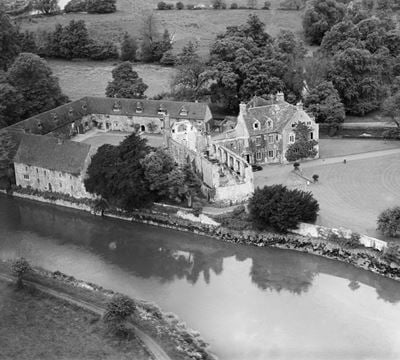
Aylesford
The Friars, Aylesford, 1932

Aylesford
The Friars, Aylesford, 1951
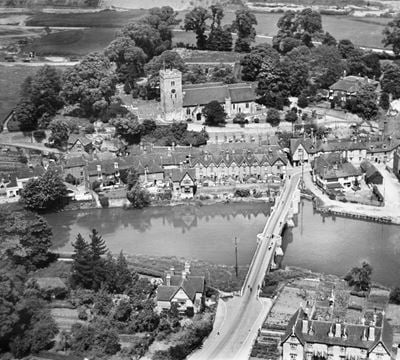
Aylesford
St Peter's Church and Aylesford Bridge, Aylesford, 1930

Aylesford
Aylesford Bridge and the village, Aylesford, 1953

Basted
Basted Paper Mills, Basted, 1948
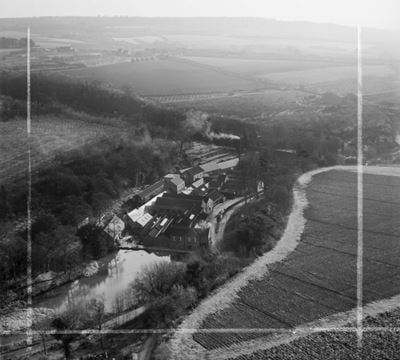
Basted
Basted Paper Mills and the surrounding countryside, Basted, 1948
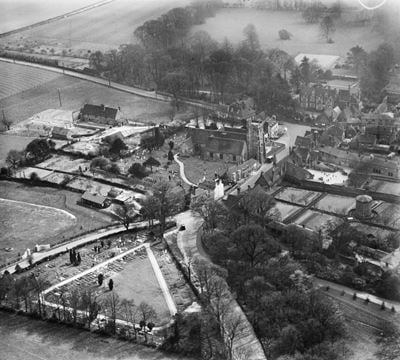
Wrotham
Wrotham cemetery and St George's Church, Wrotham, 1929
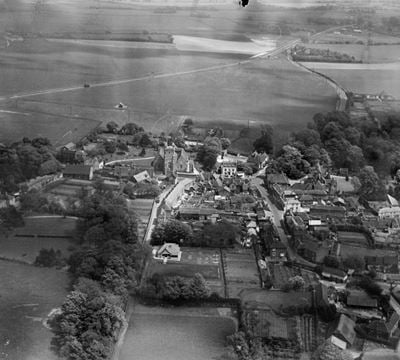
Wrotham
St George's Church and the village, Wrotham, 1930
Tonbridge and Malling in the Historic England Archive
The Historic England Archive cares for over 15 million images, dating from the 1850s to the present day. Discover stunning images of Tonbridge and Malling's past. Skip this section and go to stories about heritage
Charles George Harper Collection
Tonbridge, Tonbridge And Malling, Kent
Date created: 1892 - 1933
A view from the north-east of the Gatehouse to Tonbridge Castle, and the adjoining Georgian house, now in use as Council Offices
Eric de Mare
Hadlow, Tonbridge And Malling, Kent
Date created: 1945 - 1980
Exterior view of Hadlow Castle showing upper details of the tower. The tower is 170 feet high and was built between c.1838-40.
John Gay Collection: Counties
Tonbridge And Malling, Kent
Date created: 1956
The south front of Ightham Mote, seen from the south-east through bare branches, with snow on ivy in the foreground
Charles George Harper Collection
Watts Cross, Tonbridge And Malling, Kent
Date created: 1892 - 1933
The windmill at Watts Cross
Eric de Mare
Hadlow, Tonbridge And Malling, Kent
Date created: 1945 - 1980
Interior view of Hadlow Castle showing room number 2 with a built-in bookcase.
John Gay Collection: Counties
Tonbridge And Malling, Kent
Date created: 1956
The south front of Ightham Mote, seen from the south-east through bare branches, with snow on ivy in the foreground
Alfred Newton and Sons
Tonbridge, Tonbridge And Malling, Kent
Date created: 1903
EXTERIOR PERSPECTIVE VIEW FROM STREET
Charles George Harper Collection
Tonbridge And Malling, Kent
Date created: 1892 - 1933
A view from the south-east looking across the courtyard at Ightham Mote, showing the gatehouse and north range
Eric de Mare
Hadlow, Tonbridge And Malling, Kent
Date created: 1945 - 1980
General view of Hadlow Castle in Kent showing the tower. It was begun in 1790 by Walter May in the fashionable ornate Gothic style.
John Gay Collection: Counties
Tonbridge And Malling, Kent
Date created: 1956
The north front of Ightham Mote, with snow on the ground, viewed from the north-east through pine branches
Alfred Newton and Sons
Tonbridge, Tonbridge And Malling, Kent
Date created: 1903
GENERAL VIEW FROM STREET
Stories about heritage in your local area
Historic England publishes news, blogs, research, videos, and podcasts celebrating England's rich heritage. Discover the stories we have about Tonbridge and Malling. Skip this section and go to education
The History of England’s Village Greens
Mentions Quintain
The origins of village greens in England date back to the early Middle Ages. Village greens are open spaces that can be registered.
What Is the Oldest Building in England?
Mentions Coldrum Megalithic Tomb, Trottiscliffe
From the oldest church to archaeological remains, here are the contenders for England's oldest building.
12 Things to Know About the ‘Austerity Games’: The 1948 London Olympics
Mentions Finnish Olympic Sauna
Find out more about the cash-strapped London Olympic Games of 1948.
A Brief History of Burial Sites in England
Mentions Kit's Coty House Long Barrow
Discover how burial rites and memorials to the dead have changed in England throughout history
“I’m Sorry But What Is a Scheduled Monument?”
Mentions Kit's Coty House Long Barrow
We’ve had Scheduled Monuments (sometimes known as Ancient Monuments) since 1882 when the Ancient Monuments Protection Act was passed.
Hidden Historic Sauna in Kent Gains Listed Status
Mentions Finnish Olympic Sauna
A hidden historic Finnish sauna in Aylesford, Kent, donated for the 1948 London Olympics, has been listed at Grade II
Groundbreaking Women of Science Celebrated
Mentions Ferox Hall
Historic England and The Royal Society celebrate International Women’s Day by bringing to light the exceptional achievements of female scientists
Tonbridge and Malling's social history through photos
Over 10,000 images from the Historic England Archive have been specially selected and re-captioned for teachers, students, and anyone who wants to learn more about their local area. Skip this section and go to grant-aided places
Tonbridge Castle, Tonbridge, Kent
Period: Medieval (Middle Ages) (1066 - 1484)
The only remains of the castle are the mound, part of the moat and curtain wall and the Gatehouse.
Tonbridge Castle, Tonbridge, Kent
St Leonard's Tower, St Leonards Street, West Malling, Kent
Period: Medieval (Middle Ages) (1066 - 1484)
St Leonard's Tower was built by Gundulf Bishop of Rochester in 1077-1108 as his fortified residence or castle.
St Leonard's Tower, St Leonards Street, West Malling, Kent
Little Kitts Coty House, Aylesford, Kent
Period: Prehistoric (to AD42)
This Neolithic chambered tomb is also known as The Countless Stones, and is now little more than a collapsed pile of sarsen stones.
Little Kitts Coty House, Aylesford, Kent
Kent street scene
Period: 1950s (1950 - 1959)
Street scene of timber framed houses and people walking past. Taken in Kent.
Kent street scene
Hoppers Memorial, Church of St Mary, Church Street, Hadlow, Kent
Period: Victorian (1837 - 1901)
This memorial commemorates 30 hop pickers who drowned in 1853.
Hoppers Memorial, Church of St Mary, Church Street, Hadlow, Kent
Hadlow Castle, Hadlow, Kent
Period: Victorian (1837 - 1901)
Hadlow Castle was begun in 1790 by Walter May.
Hadlow Castle, Hadlow, Kent
Tags
Chequers Inn, High Street, Tonbridge, Kent
Period: Edwardian (1902 - 1913)
A view of the 15th century half timbered house.
Aylesford Paper Mills, New Hythe, Kent
Period: 1950s (1950 - 1959)
A teenage boy at work in a testing laboratory, at the Reed Paper Group site at Aylesford


